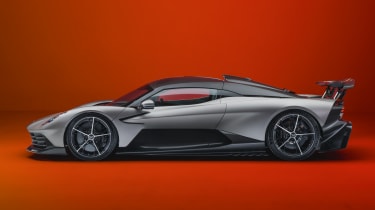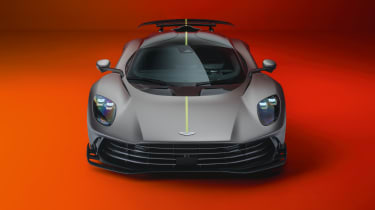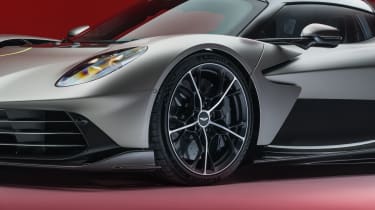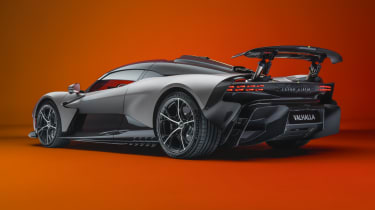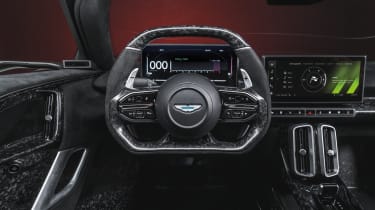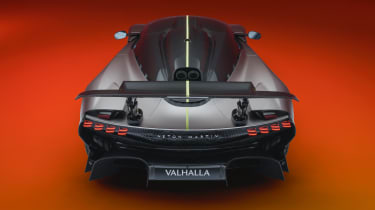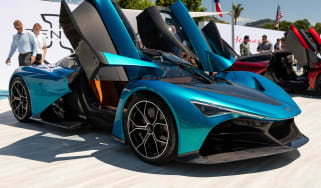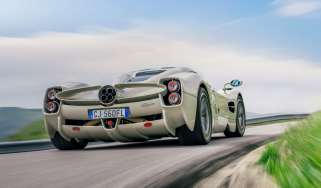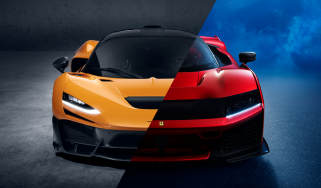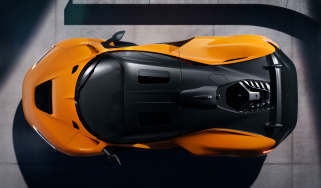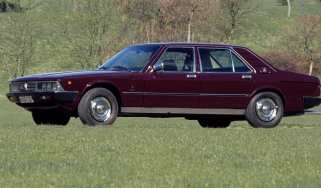The 1064bhp Aston Martin Valhalla hypercar is almost here
After half a decade and four CEOs, Aston Martin’s first plug-in hybrid supercar is finally ready, with all 1064bhp, 217mph and £850,000 of it aimed directly at Ferrari and Lamborghini
Finally revealed in production specification as a foil for the Lamborghini Revuelto and the Ferrari SF90’s replacement, the Aston Martin Valhalla hybrid hypercar is here. A long time in the works, what was first christened Son of Valkyrie, has evolved into a 1064bhp, four-wheel-drive, 217mph hyper hybrid that breaks ground even the Valkyrie never touched, entering production now as what Aston Martin calls ‘a car of firsts’. Each costing from around £600,000, first examples will hit the road in 2025.
Just under two years after Andy Palmer introduced the idea of Aston’s second-coming hypercar to pick up where the Valkyrie left off, ex-AMG CEO Tobias Moers took his place and swiftly mandated a fundamental rethink, steering the project towards series-production supercar territory. Then former Ferrari boss Amedeo Felisa took over and oversaw development, before ex-Bentley man and Aston’s new CEO, Adrian Hallmark, arrived. It is Hallmark who will finally see the Valhalla delivered to customers. And, it hardly needs saying, after all this time the car has evolved significantly from the one with a bespoke Aston Martin-developed V6 that Palmer first envisaged to get his IPO over the line.
> Here’s the Aston Martin Valkyrie LMH in its final Le Mans-ready form
A number of pressing questions will be asked of the car that was once called AM‑RB 003 and labelled ‘Son of Valkyrie’. Can a flagship Aston Martin be a turbocharged V8, mid-engined hybrid? Does it escape the shadow of its progenitor and the car it was originally destined to carry on the bloodline of, the Adrian Newey-penned, Cosworth V12-engined, 11,100rpm-revving Valkyrie? And then there’s the Vanquish, Aston Martin’s outstanding new V12-engined GT (and likely Newey’s new company car when he joins AML in 2025). Even though the Valhalla will undoubtedly operate on a higher performance plane, will it be any more desirable, any more fitting as an Aston Martin flagship, and for more than twice the price? For the time being, until we drive it, these questions will remain unanswered, but what we can do is regale you with details of its deeply impressive, high-tech, high-performance constitution. Welcome to Valhalla.
It’s a funny old world when a thousand-horsepower hybrid is considered a ‘junior’ hypercar, but it is into this arena, not the one containing the c1200bhp, £2million+ McLaren W1 and Ferrari F80, that the Aston Martin Valhalla finally wades into battle. Instead, the three-way showdown will be with the Lamborghini Revuelto and whatever takes the place of the Ferrari SF90.
More pragmatic than the original concept it may be, but the production Valhalla isn’t anything like a conventional Aston Martin. Developed in close collaboration with Aston Martin Performance Technologies (AMPT), the F1 team’s consulting arm, it will be only the third Aston Martin road car, after the One‑77 and Valkyrie, to use a carbonfibre chassis. It will also be Aston Martin’s first plug-in hybrid, with combined outputs of 1064bhp and 811lb ft. Even though Aston Martin calls it the company’s first ‘series-production mid-engined supercar’, the Valhalla that will reach customers will still be limited in numbers. That said, 999 units does mean there will eventually be more than ten Valhallas for every One‑77.
Visually, the 2019 car that we last saw poking out of Q’s wind tunnel in No Time to Die has changed from concept to production car with the additions required to drive it on the road defining its appearance. This car is more identifiably an Aston Martin and more conventionally attractive, exchanging the earlier, bottom-feeding mouth for a face that belongs in the current Aston family. Up top the sculpted air-scoop that feeds the V8 engine and guides air over the car has survived the transition from concept to production. Further back, the engine lid retains the two prominent top-exit exhausts and the air-outlet gills. At the rear, the cavernous, Valkyrie-like venturi tunnels have shrunk, with another two exhaust exits now integrated. And the updated tail-lights are now arranged in four stacks per side, rather than five.
All of the bodywork is, as you’d expect, carbonfibre, which can be specced with varying degrees of weave exposure. Upper and lower carbon packs are available, and the finish can be satin, gloss, or tinted in a choice of red, blue or green. Also offered are six bespoke liveries that reference Aston’s motorsport heritage.
The second static concept that arrived in 2022, when Tobias Moers had a go at bringing the car to production, served as the true north star for this production car. Although there has been considerable evolution from that car too; it’s all been nipped and tucked and refined – just look at those aggressive F1-style vortex-generating fins on the side-skirts. Another big change to the car first became apparent when prototypes were spotted at the Nürburgring sporting a large, hydraulically suspended active rear wing. For context, Adrian Newey and the Aston Martin design team deliberately avoided such a solution for the Valkyrie in order not to spoil its silhouette. Thus the Valhalla breaks ground that even the Valkyrie left untouched – ‘a car of firsts’, as Aston calls it.
Other parts of the aero are said to be Valkyrie-influenced, however, with active elements at the front and rear featuring an automated DRS function to ‘bleed off’ downforce as speeds rise when in Race mode. Aston claims the Valhalla develops maximum downforce ‘in excess of 600kg’ and that this is maintained by the active aero as it accelerates to its top speed of 217mph (the other headline performance stat is 0-62mph in 2.5sec). The goal here was to keep the car’s performance envelope broad and accessible, to maximise driver confidence.
The Mercedes-AMG-derived 4-litre twin-turbo V8 is the same unit used in the AMG GT Black Series – the dry-sump, flat-plane-crank M178 LS2. The version sitting midships in and powering the rear wheels of the production Valhalla has been opened up by Aston Martin in order to increase its output to 817bhp (up from 720bhp in the aforementioned Black Series). Changes include new cams, new exhaust manifolds and stronger, weight-optimised pistons, while a larger compressor wheel means the turbos can force some 20 per cent more air into the engine compared to the V8 in the DBX707.
The engine works in tandem with a hybrid system for the combined 1064bhp output, which is a significant step up on the 986bhp figure initially projected for the Valhalla. There are three electric motors in total, with two feeding a wheel each at the front, allowing for electric torque-vectoring (E-TV) and also providing reverse ‘gear’. These bespoke motors are housed within the new P4 front electric drive unit, featuring high-strength neodymium-iron-boron magnets and what Aston describes as a new cooling strategy. When driving in EV mode, your Valhalla will be a 248bhp, front-wheel-drive electric hypercar.
The third, smaller motor sits within the all-new eight-speed dual-clutch transmission (that also houses the Valhalla’s new hydraulically actuated E‑LSD) and is there to start the V8, torque-fill where appropriate and charge the high-voltage batteries, which are plumbed in using a 400-volt electric architecture. There is no physical connection between front and rear axles.
The size of the battery is as yet undisclosed in the conventional sense, with Aston simply saying it has 560 cells. The fairly measly 8.6-mile electric-only range (at up to 80mph) is a little up on the Lamborghini Revuelto’s 6 miles, but significantly down on the Ferrari SF90’s 15.5 miles. So a battery capacity closer to 3.8kWh (Lambo) than 7.9kWh (Ferrari) is safe to assume and will have played a part in the Valhalla’s minimum dry weight of 1655kg. The original target was closer to the now-discontinued SF90’s dry weight of 1570kg, but the actual figure is still 115kg less than the Revuelto’s 1772kg dry.
You’d have thought with its carbon tub the Aston might have been the flyweight of the trio, though the heavyweight Revuelto majors on carbon, too. Designed and engineered by AMPT, the tub has a lower section weighing just 74.2kg, with aluminium subframes attached front and rear, from which the car’s suspension hangs. At the front the Valhalla features F1-style push-rods with inboard springs and dampers, allowing the wheelarch to be clear for optimised airflow. At the rear, there’s a five-link arrangement, and there are bespoke-tune Bilstein DTX adaptive dampers all-round.
The Valhalla will be fitted with 20-inch front and 21-inch rear wheels, shod as standard with AML-spec Michelin Pilot Sport S 5 tyres. Opt for lightweight magnesium wheels (the 12kg saving for which is already accounted for in the quoted minimum weight) and they’ll wear Cup 2 rubber, with sizes for both tyre choices being the same – 285/30 at the front and 335/35 at the rear.
Behind the wheels are carbon-ceramic discs, 410mm at the front and clamped by six-piston calipers, 390mm with four-piston calipers at the rear. Regenerative braking is via the front e-axle when actively braking, and via the transmission-mounted e-motor when off-throttle. There are regenerative effects incorporated into the torque-vectoring, too. Braking is by wire, to allow full optimisation and consistency of stopping power and brake feel between the friction and regenerative elements.
The Valhalla’s Integrated Vehicle Dynamics Control (IVDC) is the latest iteration of the system first introduced in the DB12. Its job is to seamlessly manage the interactions between the aero functions and the suspension, steering and powertrain systems to maintain dynamic cohesion and a natural-feeling driving experience. Here, obviously, hybrid electric power and all-wheel drive were significant new elements that had to be integrated.
Indeed, this was the biggest challenge for Aston Martin’s director of vehicle performance, Simon Newton, who claims that it is ‘unprecedented dynamic bandwidth that separates Valhalla from its class rivals’. Fighting talk indeed. The driver can manipulate the control systems, and consequently the character of the car, via four driving modes: Sport, which is the default setting on start-up, Pure EV, Sport+ and Race.
Speaking of the driver, the cockpit of the production Valhalla forgoes some of the proposed technology suggested at the concept’s reveal, including the plan for owners to mount their phone on the dashboard and use an app for the car’s infotainment system. However, that’s not to say the production Valhalla’s cabin is run-of-the-mill. The steering wheel is a slightly odd-looking ‘squircle’ shape with a flat top and bottom, not unlike those in the McLaren W1 and Ferrari F80. It’s trimmed with forged recycled carbonfibre, with large paddles behind, while the wheel-mounted controls are recognisable from the rest of the Aston Martin range.
Happily, the driver’s display is larger and with brighter graphics than the ones in Aston’s current GTs and sports cars. Bright green highlights complement aspects of the cabin’s trim, and there’s a unique Race-mode layout with a large tachometer, F1-inspired shift lights, tyre pressure and temperature monitoring and a g-meter, as well as a digital speed readout. The overall appearance is very crisp and clear, unlike in some Astons of late.
More familiar are the gear selector, the start/stop button and the enjoyably tactile drive-mode rotary control that surrounds it, set within a flowing, forged-carbon trim element. There are distinctive vertical air vents in the middle, below a selection of HVAC controls and the infotainment screen. Within the user interface, the driver can select striking new visuals to show how the car is managing its various power sources. There are also selectable ADAS modes, so that you can easily switch off unwanted but legally required nannying and nagging functions.
The seats are one-piece carbon items but not quite as radical as the sculpted tubs with padded elements you find in the Valkyrie. The footwell is similarly raised, if not to quite such an extreme hip-to-heel driving position. There’s what Aston calls an ‘Amphitheatre line’ that wraps around the cabin, while the carbon dash onto which the HMI screen is mounted is described as a brace. Overall the design is minimalist, but with some appealingly sculptural touches. It’s sparse, yet sumptuous. Inside, as outside, Aston Martin’s Q division will be on hand to realise the specification desires of each of the Valhalla’s 999 buyers.
The Valhalla’s pricing, as with the production numbers, has been subject to change over the years. Back in 2019, this was to be a 500-off car priced at seven figures. Then when it became a ‘series production’ car (still limited to under 1000 units) the price dropped to c£600,000. A lot’s happened in the world to make cars much more expensive than they once were, so don’t be surprised if most Valhallas, with a bit of Q personalisation, end up costing their buyers in the region of £1million apiece.
Pulled in various directions over the years, the Valhalla has still turned out to be an Aston Martin quite unlike any other. You can establish as much from the specs alone. Whether it’s Aston enough in character remains to be confirmed, as does how it stacks up in a fiercely competitive marketplace of senior supercars. Customers will find out in the second half of 2025.
Aston Martin Valhalla specs
| Engine | V8, 3982cc, twin-turbo, plus three e-motors (two front, one rear) |
| Power | 1064bhp |
| Torque | 811lb ft |
| Weight | 1655kg (dry) |
| Power-to-weight | 653bhp/ton (dry) |
| 0-62mph | 2.5sec |
| Top speed | 216mph |
| Basic price | £850,000 |
This story was first featured in evo issue 330.
